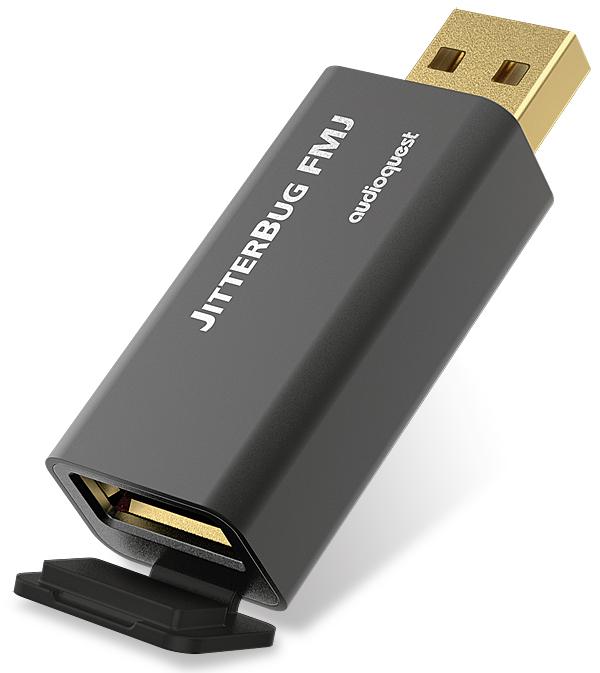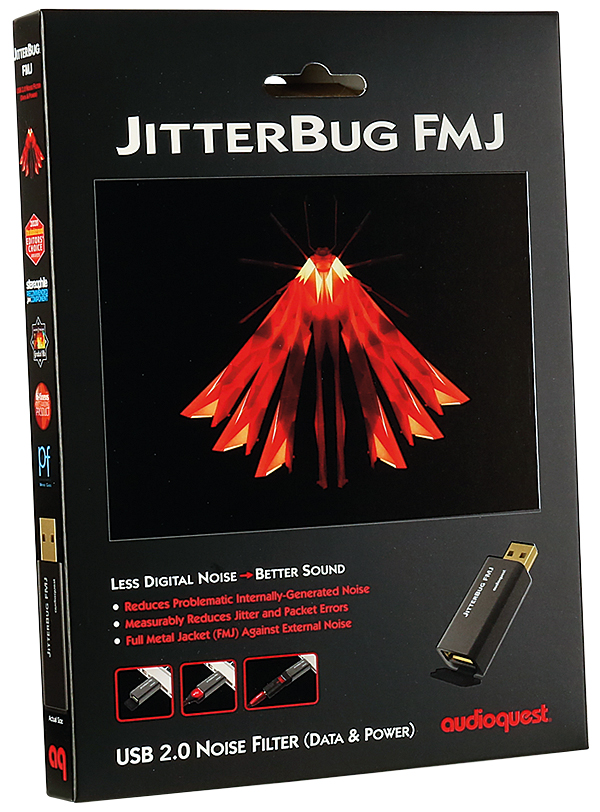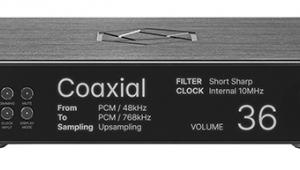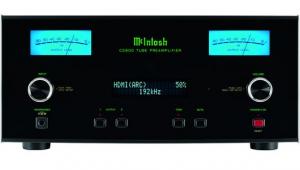AudioQuest JitterBug FMJ

 Revised and refined, and now clad in metal, AudioQuest's USB noise filter is still a compelling upgrade for portable DAC users.
Revised and refined, and now clad in metal, AudioQuest's USB noise filter is still a compelling upgrade for portable DAC users.
As we described in our review of AudioQuest's original JitterBug [HFN Oct '15], this little serial plug-in is not a re-clocker for digital datastreams, but rather a purely passive device (drawing no power from the USB hub) that provides transformer-isolation and RF filtering of both the 5V USB 'VBUS' and its differential data lines. The promise, according to AQ, goes something like this: 'the dual-discrete noise-dissipation circuits reduce internally generated RF noise for improved streaming audio, [reducing] jitter and packet errors'.
Today the JitterBug is available as the £49 JitterBug FMJ – still a USB-A-to-USB-A device, with a male plug on one end and a female on the other, but the case is now an alloy sleeve – hence Full Metal Jacket. There's a rubber cap too, heavily loaded with carbon for further screening, provided to cover the output socket if the JitterBug FMJ is plugged into an unused USB port on the same or adjacent hub.
Fog Of Confusion
Ordinarily, the JitterBug FMJ will be used as an in-line filter for the connection between a USB music server (PC/Mac) and your choice of outboard DAC. Of course it's tempting to discount the potential of such a device, particularly if there's no discernible difference in basic harmonic distortion or noise from the DAC under test. And, indeed, most of the time there isn't because the 'Bug' is not altering the data as much as the RF environment – the ambient fog – that it's slogging through.
Moreover, while the 'dual filtering' of both VBUS and USB datalines is intended to remove spurious RF, particularly from the latter, the LPF will necessarily influence the response and waveshape of the data signal. A data edge risetime of around 14.8nsec with a Vp-p of 3.6V is typical from the 'Bug', and this may differ from the native output of the USB host. How this impacts on the performance of the USB sink (receiver) and downstream DAC will necessarily vary device by device.
![]() Nipped By The Bug
Nipped By The Bug
The proof is in the listening, writes Andrew Everard, and while an obvious use will be with AudioQuest's own DragonFly DACs, it's worth noting that the Cobalt model [HFN Oct '19] already includes similar filtering. However, having used an original JitterBug on and off in my computer audio rigs for years, I can report that it brings marginal, but worthwhile, gains in clarity.
The FMJ variant brings equally marginal improvements to the party but with a small bonus, probably best described as a little extra 'bite' to the sound, and a slight sharpening in its resolution of any recorded ambience. For example, on the Gesualdo Six recording of festive music, there's a slightly greater sense of the chapel acoustic around the performers, while the intimacy of the Rembrandt Trio's A Wind Invisible Sweeps Us Through The World wraps itself around the listener with just a little more conviction and warmth.

The effects are less striking with busier, more commercial recordings, which tend to cover up the effects of such noise, and they'll also vary between digital sources and indeed DACs. So... I heard the JitterBug FMJ doing more when used with an old Mac mini feeding a budget DAC than I did with a well sorted USB-output streamer feeding the iFi Audio Pro iDSD Signature.
Hi-Fi News Verdict
The JitterBug FMJ has the capacity to improve the sound of your USB DAC, especially in busy wireless environments, and while the gains are subtle, they're typically worth having. The effect varies with the partnering equipment, so some experimentation with a single device is advised before you plug every USB port in sight with JitterBugs! After all, at the price, there's little to lose in giving the 'FMJ' a try in a USB-based audio system.
Price: £49


















































